
| Version | Summary | Created by | Modification | Content Size | Created at | Operation |
|---|---|---|---|---|---|---|
| 1 | Ki Hyun Kim | + 1148 word(s) | 1148 | 2020-09-27 05:49:08 | | | |
| 2 | Felix Wu | -93 word(s) | 1055 | 2020-10-21 08:22:07 | | |
Video Upload Options
Anthocyanins, betalains, riboflavin, carotenoids, chlorophylls and caramel are the basic natural food colorants used in modern food manufacture. Betalains, which are composed of red–violet betacyanin and yellow betaxanthins, are water-soluble pigments that color flowers and fruits. Betalains are pigments primarily produced by plants of the order Caryophyllales. Because of their anti-inflammatory, cognitive impairment, anticancer and anti-hepatitis properties, betalains are useful as pharmaceutical agents and dietary supplements. Betalains also exhibit antimicrobial and antimalarial effects, and as an example, betalain-rich Amaranthus spinosus displays prominent antimalarial activity. Studies also confirmed the antidiabetic effect of betalains, which reduced glycemia by 40% without causing weight loss or liver impairment. These findings show that betalain colorants may be a promising alternative to the synthetic dyes currently used as food additives
1. Introduction
Betalain-rich extracts from food sources has been investigated for the antitumoral potential in animal models and cancer cell lines [1][2][3]. Betanin, the original nutritional betacyanin, show significant inhibition to the growth of tumor cells of the stomach, breast, lung, colon and central nervous system [4]; induce apoptosis in K562 human myeloid leukemia cells; and weakly exhibit epigenome-regulated gene expression in MCF-7 breast cancer cells. However, the potential antiproliferative, chemopreventive and epigenetic activities of betaxanthins are yet to be investigated [5]. Recently, the focus has shifted to the usage of natural products to improve human health instead of prevention diseases [6]. Thus, the number of studies on the application of betalains in medical sciences is increasing. Therefore, a narrative review of the therapeutic uses of betalains and the genes involved in betalain metabolism (Figure 1) may help future investigations regarding the advantages of natural products.
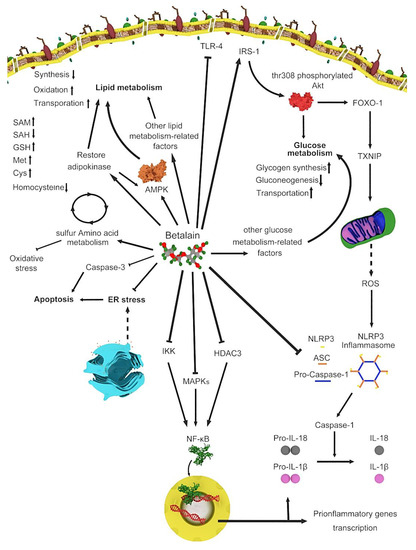
Figure 1. Various genes and routes involved in betalain metabolism.
2. Therapeutic Effect
2.1. Antidiabetic Activity
The hypoglycemic action of the extract is attributed to saponins, which prevent glycogenolysis and gluconeogenesis [7]. Therefore, the molecular pathways that affect this hypoglycemic mechanism must be thoroughly examined. Several studies showed that the hypoglycemic activity of the BVc extract, which is mediated via prevention of glucose transporters, may be caused by flavonoids. For example, quercetin, which is found in BVc, exhibited antidiabetic effects by preventing the action of the intestinal glucose transporter GLUT2 (Figure 2b) [8]. Another hypoglycemic mechanism is the inhibition of α-amylase and α-glucosidase activities by flavonoids [9]. For example, two flavanol glycosides isolated from Salsola kali actively inhibited α-amylase activity [10]. The digestion and absorption of carbohydrates can be delayed by inhibiting α-amylase activity, consequently suppressing postprandial hyperglycemia (Figure 2a) [11]. Vitexin-2-O-glycoside, a C-glycosyl flavone-containing vitexin found in the leaves and seeds of BVc, strongly inhibits α-glucosidase (Figure 2a) [12]. This finding suggests that α-glucosidase inhibition serves as the primary mechanism underlying the hypoglycemic effect previously observed in diabetic rats [13][12].
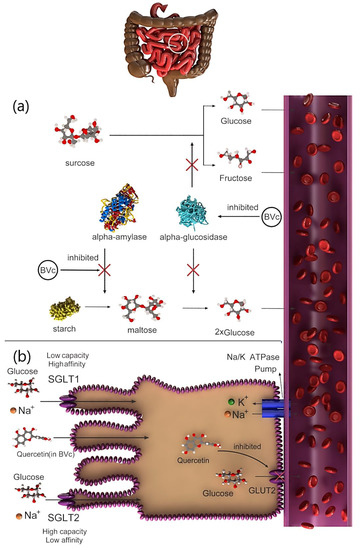
Figure 2. Mechanism of hypoglycemic function of Beta vulgaris var. cicla L. (BVc) by (a) alpha-amylase and alpha-glucosidase to control glucose in diabetic patients and (b) inhibiting glucose transporter isoform 2 (GLUT2).
2.2. Cardiovascular Disease (CVD)
CVD is the leading cause of death and disability worldwide. Unhealthy diet is considered as one of the most significant risk factors for CVD [14]. Total cholesterol, LDL cholesterol (LDL-c), and triglyceride concentrations are risk markers of CVD (Figure 3). The effects of dietary quinoa (quinoa contains a marked concentration of betalain: 630.4 mg/100 g dry portion) on risk parameters of CVD were evaluated after 30 days of consumption in 22 students between 18 and 45 years old. Approximately 42.2% and 40.7% of the individuals had hypotension and decreased body weight, respectively [15]. Diet and foods containing extruded amaranth oil reduced total cholesterol, LDL-c and triglycerides by approximately 50%.
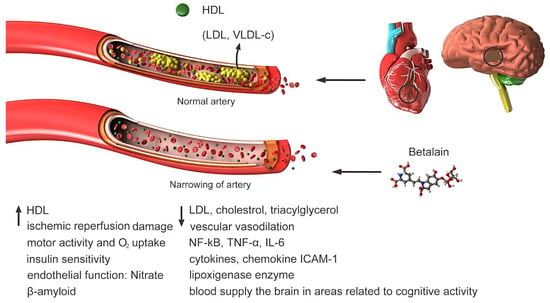
Figure 3. Highly concentrated low-density lipoprotein (LDL) is associated with increased cholesterol deposition in the walls of blood vessels and atherosclerosis (susceptibility to cardiovascular disease) and should be tried to reduce its level in the blood. Clogged or narrowed arteries can block blood flow to the heart, brain or other organs. This can lead to stroke, heart attack or even heart failure. Betalain reduces blood LDL, increases HDL and vascular vasodilation. Other factors that increase or decrease under the influence of betalain are shown in Figure.
2.3. Hepatitis
In a human study, a supplement containing uncooked red beet juice reduced non-HDL-c, LDL-c and total cholesterol [16]. In AML mice, treatment with betanin decreased LDL levels [17]. The consumption of a non-lipid diet increased serum TC, TC/HDL-c ratio, triglyceride (TAG) and atherogenic index, but decreased short-chain fatty acid (SCFA) production in rats [18].
2.4. Antimicrobial and Antiviral Activities
Betalains exhibit antimicrobial and antimalarial effects, whereas betalain-rich Amaranthus spinosus shows prominent antimalarial activity in mice owing to its high levels of betanin and amaranthine, which can chelate the required inner cations (Fe+2, Ca+2 and Mg+2) and block the intracellular transport of choline in parasites [19]. Extracts of Opuntia matudae, which contain betalains, prevent the growth of Escherichia coli O157: H7 (Figure 4) [20].
The antimicrobial activity of betalains is speculated to be caused by their negative effects on the function, structure and penetration of the microbial cell membrane, ultimately causing cell death [21]. Although betalains are known to exert broad-spectrum antimicrobial activity, only their microbial prevention mechanism was reported. The basic molecular and cellular mechanism underlying the antimicrobial effect of betalains will be highlighted in future studies [21].
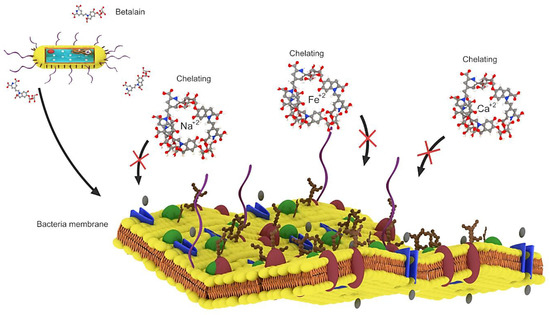
Figure 4. Betalain by chelating Fe+2, Ca+2 and Mg+2 ions which are among the basic needs of bacteria, betalain prevents them from entering the bacteria, resulting in the death of the bacteria.
2.5. Cognitive Impairment
Most of the people with cognitive impairment diseases such as dementia and Alzheimer’s disease suffer from cerebral circulatory disorders. Nitrate, which is metabolized and produced in beet nitric oxide (NO), has the ability to improve circulatory problems [22][23]. In a study of 75-year-old volunteers on a diet containing red beet juice, a significant increase in blood flow was observed by magnetic resonance imaging (MRI) of the brain in areas related to cognitive activity [24].
2.6. Anticancer Activity
There has been a growing interest in the anticancer properties of beets and the use of beet products or their ingredients as dietary supplements for cancer prevention [25]. Among the different atypical mechanisms underlying the chemopreventive attributes of beetroot at the cellular level, the anti-inflammatory, antioxidant, proapoptotic, antiproliferative and free radical-scavenging mechanisms have been investigated. Previous studies have shown marked increases in BAX, caspase 9, caspase 3, cytochrome and ROS as well as decreases in BCL2 and PARP, causing DNA damage and ultimately leading to apoptosis. This process is shown in Figure 5 [26].
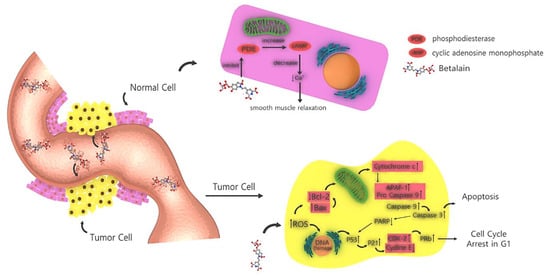
Figure 5. How betalain affects cancer cells and induces apoptosis in them vs. how betalain affects normal cells.
References
- Gautam, S.; Saxena, S.; Kumar, S. Fruits and vegetables as dietary sources of Antimutagens. J. Food Chem. Nanotechnol. 2016, 2, 97–114.
- Oroian, M.; Escriche, I. Antioxidants: Characterization, natural sources, extraction and analysis. Food Res. Int. 2015, 74, 10–36.
- Rahman, I.; Biswas, S.K.; Kirkham, P.A. Regulation of inflammation and redox signaling by dietary polyphenols. Biochem. Pharmacol. 2006, 72, 1439–1452.
- Ildefonso Rodríguez-Ramiro; Sonia Ramos; Laura Bravo; Luis Goya; Amanda E. Martin; Procyanidin B2 induces Nrf2 translocation and glutathione S-transferase P1 expression via ERKs and p38-MAPK pathways and protect human colonic cells against oxidative stress. European Journal of Nutrition 2011, 51, 881-892, 10.1007/s00394-011-0269-1.
- Satoshi Numazawa; Makie Ishikawa; Aya Yoshida; Sachiko Tanaka; Takemi Yoshida; Atypical protein kinase C mediates activation of NF-E2-related factor 2 in response to oxidative stress. American Journal of Physiology-Cell Physiology 2003, 285, C334-C342, 10.1152/ajpcell.00043.2003.
- Dieter Strack; Thomas Vogt; Willibald Schliemann; Recent advances in betalain research. Phytochemistry 2003, 62, 247-269, 10.1016/s0031-9422(02)00564-2.
- Massiot, G.; Dijoux, M.G.; Lavaud, C.; Men-Olivier, L.L.; Connolly, J.D.; Sheeley, D.M. Seco-glycosides of oleanolic acid from Beta vulgaris. Phytochemistry 1994, 37, 1667–1670.
- Song, J.; Kwon, O.; Chen, S.; Daruwala, R.; Eck, P.; Park, J.B.; Levine, M. Flavonoid inhibition of sodium-dependent vitamin C transporter 1 (SVCT1) and glucose transporter isoform 2 (GLUT2), intestinal transporters for vitamin C and glucose. J. Biol. Chem. 2002, 277, 15252–15260.
- Yilmazer-Musa, M.; Griffith, A.M.; Michels, A.J.; Schneider, E.; Frei, B. Grape seed and tea extracts and catechin 3-gallates are potent inhibitors of α-amylase and α-glucosidase activity. J. Agric. Food Chem. 2012, 60, 8924–8929.
- Tundis, R.; Loizzo, M.R.; Statti, G.A.; Menichini, F. Inhibitory effects on the digestive enzyme α-amylase of three Salsola species (Chenopodiaceae) in vitro. Pharmazie 2007, 62, 473–475.
- Bischoff, H. The mechanism of alpha-glucosidase inhibition in the management of diabetes. Clin. Investig. Med. 1995, 18, 303–311.
- Li, H.; Song, F.; Xing, J.; Tsao, R.; Liu, Z.; Liu, S. Screening and structural characterization of α-glucosidase inhibitors from hawthorn leaf flavonoids extract by ultrafiltration LC-DAD-MS n and SORI-CID FTICR MS. J. Am. Soc. Mass Spectrom. 2009, 20, 1496–1503.
- Ş Bolkent; R Yanardağ; A Tabakoğlu-Oğuz; Ö Özsoy-Saçan; Effects of chard (Beta vulgaris L. var. cicla) extract on pancreatic B cells in streptozotocin-diabetic rats: a morphological and biochemical study. Journal of Ethnopharmacology 2000, 73, 251-259, 10.1016/s0378-8741(00)00328-7.
- N. Burgess Record; Daniel K. Onion; Roderick E. Prior; David C. Dixon; Sandra S. Record; Fenwick L. Fowler; Gerald R. Cayer; Christopher I. Amos; Thomas A. Pearson; Community-Wide Cardiovascular Disease Prevention Programs and Health Outcomes in a Rural County, 1970-2010. JAMA 2015, 313, 147-155, 10.1001/jama.2014.16969.
- Flávia Maria Vasques Farinazzi-Machado; Sandra Maria Barbalho; Marie Oshiiwa; Ricardo Goulart; Osvaldo Pessan Junior; Use of cereal bars with quinoa (Chenopodium quinoa W.) to reduce risk factors related to cardiovascular diseases. Food Science and Technology (Campinas) 2012, 32, 239-244, 10.1590/s0101-20612012005000040.
- S Asgary; Sayed Mohammad Afshani; A Sahebkar; Mahtab Keshvari; M Taheri; E Jahanian; Mahmoud Rafieian-Kopaei; F Malekian; Nizal Sarrafzadegan; Improvement of hypertension, endothelial function and systemic inflammation following short-term supplementation with red beet (Beta vulgaris L.) juice: a randomized crossover pilot study. Journal of Human Hypertension 2016, 30, 627-632, 10.1038/jhh.2016.34.
- Chen, H.; Xu, Y.; Wang, J.; Zhao, W.; Ruan, H. Baicalin ameliorates isoproterenol-induced acute myocardial infarction through iNOS, inflammation, oxidative stress-myeloperoxidase/low-density lipoprotein in rat. Int. J. Clin. Exp. Pathol. 2015, 9, 10139–10147.
- Parisa Rahimi; Alireza Ostadrahimi; Alireza Ostadrahimi; Ahmad Separham; Mohammad Asghari Jafarabadi; Betalain- and betacyanin-rich supplements’ impacts on the PBMC SIRT1 and LOX1 genes expression and Sirtuin-1 protein levels in coronary artery disease patients: A pilot crossover clinical trial. Journal of Functional Foods 2019, 60, 103401, 10.1016/j.jff.2019.06.003.
- A. Hilou; O.G. Nacoulma; T.R. Guiguemde; In vivo antimalarial activities of extracts from Amaranthus spinosus L. and Boerhaavia erecta L. in mice. Journal of Ethnopharmacology 2006, 103, 236-240, 10.1016/j.jep.2005.08.006.
- Saeed A. Hayek; Salam A. Ibrahim; Antimicrobial Activity of Xoconostle Pears (Opuntia matudae) againstEscherichia coliO157:H7 in Laboratory Medium. International Journal of Microbiology 2012, 2012, 1-6, 10.1155/2012/368472.
- J.M. Čanadanović-Brunet; S.S. Savatović; G.S. Ćetković; J.J. Vulić; S.M. Djilas; S.L. Markov; D.D. Cvetković; Antioxidant and antimicrobial activities of beet root pomace extracts. Czech Journal of Food Sciences 2011, 29, 575-585, 10.17221/210/2010-cjfs.
- Clifford, T.; Howatson, G.; West, D.J.; Stevenson, E.J. The potential benefits of red beetroot supplementation in health and disease. Nutrients 2015, 7, 2801–2822.
- Hobbs, D.A.; Kaffa, N.; George, T.W.; Methven, L.; Lovegrove, J.A. Blood pressure-lowering effects of beetroot juice and novel beetroot-enriched bread products in normotensive male subjects. Br. J. Nutr. 2012, 108, 2066–2074.
- Tennille D. Presley; Ashley R. Morgan; Erika Bechtold; William Clodfelter; Robin W. Dove; Janine M. Jennings; Robert A. Kraft; S. Bruce King; Paul J. Laurienti; W. Jack Rejeski; et al.Jonathan H. BurdetteDaniel B. Kim-ShapiroGary D. Miller Acute effect of a high nitrate diet on brain perfusion in older adults. Nitric Oxide 2011, 24, 34-42, 10.1016/j.niox.2010.10.002.
- Małgorzata Zielińska-Przyjemska; Anna Olejnik; Agnieszka Dobrowolska-Zachwieja; Michał Łuczak; Wanda Baer-Dubowska; DNA damage and apoptosis in blood neutrophils of inflammatory bowel disease patients and in Caco-2 cells in vitro exposed to betanin.. Postępy Higieny i Medycyny Doświadczalnej 2016, 70, 265-271, 10.5604/17322693.1198989.
- Kapadia, G.J.; Rao, G.S. Anticancer effects of red beet pigments. In Red Beet Biotechnology; Springer: Berlin, Germany, 2013; pp. 125–154.




